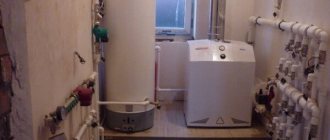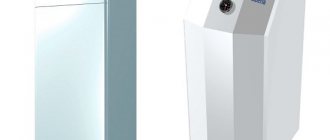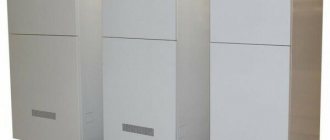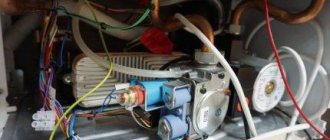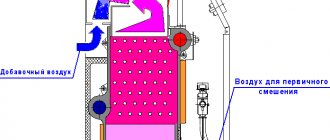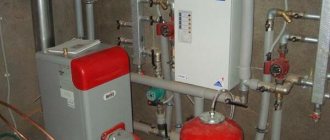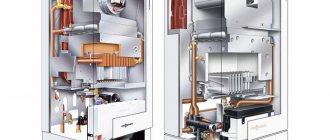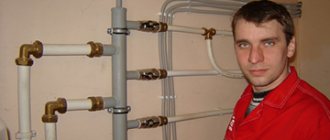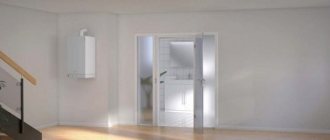Siberia gas boilers are among the TOP 3 most popular and competitive lines of heating equipment among domestic manufacturers. All models have an excellent efficiency of 90%, do not have a record, but rather low gas consumption, and have a simple, reliable and trouble-free design. There are both models with steel and cast iron heat exchangers, universal floor-mounted and compact wall-mounted.
All boilers are characterized by an average market price in the budget price segment - from 19 thousand rubles for the simplest models.
In the article we will look at the best models of wall-mounted and floor-standing gas boilers Siberia, how they behave in practice, what advantages and, most importantly, disadvantages are noted by the owners, as well as what malfunctions may arise during the operation of boiler units in real conditions.
Why does it go out?
The main reason should be considered a gas supply interruption.
If the valve on the gas pipe is closed, or the pressure in the network is lost, the burner will go out. First of all, it is necessary to determine how much the gas pressure corresponds to the operating values. In addition, external influence factors are possible.
The burner flame largely depends on the room conditions and the presence of draft in the smoke removal system.
If there are drafts in the room, the draft may be weakened or completely disappear. then the combustion mode changes sharply and the flame goes out. Another possible reason is the occurrence of reverse draft, which may be caused by strong gusts of wind or drafts in the building.
Floor-standing gas boiler Siberia 11 single-circuit
Gas floor-standing boiler Rostovgazoapparat Siberia 11 is a single-circuit energy-independent boiler produced by the Rostov Gas Equipment Plant. The boiler is intended for heating only. Open combustion chamber with natural smoke removal. Piezo ignition. Italian EUROSIT automation unit, Polidoro burner, thermometer on the front panel. Operates on natural gas (to operate on liquefied gas, replacement of nozzles is required). Operable at reduced gas pressure. Power 11 kW. However, it is also possible to obtain domestic hot water using a single-circuit boiler. To do this, you need to connect an indirect heating boiler to the heating system. It is there that the water is heated to the required temperature. The result is a compact, convenient and very economical system that does not require an additional source of energy (for example, electricity), but operates directly from the heating boiler.
Recently, Siberia gas boilers are gaining more and more popularity and respect among... Show more
Gas floor-standing boiler Rostovgazoapparat Siberia 11 is a single-circuit energy-independent boiler produced by the Rostov Gas Equipment Plant. The boiler is intended for heating only. Open combustion chamber with natural smoke removal. Piezo ignition. Italian EUROSIT automation unit, Polidoro burner, thermometer on the front panel. Operates on natural gas (to operate on liquefied gas, replacement of nozzles is required). Operable at reduced gas pressure. Power 11 kW. However, it is also possible to obtain domestic hot water using a single-circuit boiler. To do this, you need to connect an indirect heating boiler to the heating system. It is there that the water is heated to the required temperature. The result is a compact, convenient and very economical system that does not require an additional source of energy (for example, electricity), but operates directly from the heating boiler.
Recently, Siberia gas boilers have been gaining increasing popularity and respect among consumers. This is facilitated by the presence of such significant advantages as:
14. Thoughtful development taking into account the harsh climate conditions of our country and the characteristics of gas and water supply, an ideal ratio of quality and price.
Structure of a floor-standing boiler The device consists of the following main parts: heat exchanger, cover, gas exhaust device, walls, pilot burner, main burner, frame, gas block. The automation of the Siberia boiler provides: stabilization of the gas pressure on the main burner, maintenance of the set water temperature, turning on the main burner when there is a flame on the ignition burner, turning off the device when the ignition burner goes out, in the absence of vacuum in the chimney.
Design of the Siberia apparatus:
1 gas outlet; 9 ignition burner (pilot burner), 2 heat exchanger; 10 thermometer; 3 main burner; 11 cover; 4 gas valve; 12 side wall left / right; 5 cover with piezo ignition; 13 panel; 6 thermocouple; 14 anterior wall; 7 traction sensor; 15 frame; 8 thermal breaker; 16 thermostat indicator knob (magnetic valve button). Technical characteristics of gas floor-standing boilers Siberia
| Model | 11 | 11K | 17 | 17K | 23 | 23K | 29 | 29K | 35 |
| Rated thermal power, kW | 11,6 | 11,6 | 17,4 | 17,4 | 23,2 | 23,2 | 29 | 29 | 35 |
| Reduced gas consumption | |||||||||
| natural, m3/h | 1,18 | 1,18 | 1,76 | 1,76 | 2,3 | 2,3 | 2,94 | 2,94 | 3,75 |
| liquefied, kg/h | 1 | 1 | 1,21 | 1,21 | |||||
| Approximate heating area, m2 | up to 125 | up to 125 | 100–200 | 100–200 | 100–250 | 100–250 | 150–300 | 150–300 | 150–400 |
| Flue gas efficiency, %, not less | 90 | 90 | 90 | 90 | 90 | 90 | 90 | 90 | 90 |
| Water temperature setting limit, °C | 90±5 | 90±5 | 90±5 | 90±5 | 90±5 | 90±5 | 90±5 | 90±5 | 90±5 |
| Water consumption in hot water supply mode. when heated at Δt=35°C, l/min | 3,8 | 5,5 | 7 | 8 | |||||
| Connecting thread of fittings, inch | |||||||||
| for gas supply | G½ | G½ | G¾ | G¾ | G¾ | G¾ | G¾ | G¾ | G¾ |
| Inlet/outlet | |||||||||
| to the heating part | G1½ | G1½ | G2 | G2 | G2 | G2 | G2 | G2 | G2 |
| to the water heater parts | G½ | G½ | G½ | G½ | |||||
| Internal diameter of the gas outlet pipe, dm, not less | 1,25 | 1,25 | 1,25 | 1,25 | 1,38 | 1,38 | 1,38 | 1,38 | 1,38 |
| Overall dimensions, mm | |||||||||
| height | 850 | 850 | 850 | 850 | 850 | 850 | 850 | 850 | 850 |
| width | 280 | 280 | 280 | 280 | 380 | 380 | 380 | 380 | 380 |
| depth | 560 | 560 | 560 | 560 | 560 | 560 | 560 | 560 | 560 |
| Weight, kg | 52 | 56 | 56 | 59 | 65 | 70 | 70 | 76 |
User manual
Operating Siberia boilers is not difficult at all . The owner’s only task is to maintain the cleanliness of the unit and the absence of soot, soot or ash inside the unit. Changing the mode is done by turning the knob to the desired position.
In order to light the boiler, you need to press the handle, pushing it all the way, while simultaneously pressing the piezo ignition button.
Hold in this position for some time (up to 1 minute) until a flame appears on the pilot burner.
Then the control knob is switched to the desired operating mode, which will cause the flame on the main burner to light up and heating of the coolant will begin.
The system is filled with water with the make-up tap open. The process lasts until water flows from the signal pipe, after which the tap is closed.
Download instructions Download instructions for
the Siberia floor-standing gas boiler
.
Types of devices
All single-circuit and double-circuit AGVs produced by Zhukovsky have three main varieties, which allow customers to choose a heating column depending on their available budget:
- “Economy” modification - has a set of equipment necessary only for safe operation: domestic automation, temperature sensor, heat exchanger.
- The “Standard” variation is also capable of modulating the burner flame, is controlled by a foreign control system, and can turn off when overheated, preventing damage.
- The Comfort boiler complex is distinguished by the presence of a remote control unit, technology for maintaining the set temperature, and a room thermostat.
Heater parameters
The high efficiency of the AOGV - up to 92% - means that the installation of this equipment will bring maximum heating efficiency, and this is due to the original design of the jacket. Boilers can operate in heating systems with forced or natural circulation of coolant, provided that the pressure in the system is at least 1.4 Atm. Such conditions can ensure a liquid temperature of +40/+90C.
The disadvantage of this equipment can be considered to be too much power - even the lowest-power boiler produced by the Zhukovsky plant is designed to heat an area of at least 200 m2, which means that in small houses its installation will be impractical and costly.
The burner in any modification and brand of boiler is made of stainless steel, so its durability is guaranteed. The jacket for hot water supply is made of copper, the body of the unit is coated with polymer or powder paint. Standard automation has temperature sensors and regulators to control the temperature of the coolant and prevent overheating of the boiler. The package also includes a thermocouple that controls gas flow and an air flow stabilizer, which serves to compensate for differences in air pressure during gusts of wind, and shuts off the gas in calm weather. Certificate of conformity for gas boiler AOGB
| Names | AOGB-11.6 | AOGBK-11.6 | AOGB-17.4 | AOGBK-17.4 | AOGB-23.2 | AOGBK-23.2 | AOGB-29 | AOGB-35 | AOGBK-35 |
| Indicators | |||||||||
| Rated power, kW | 11,6 | 11,6 | 17,4 | 17,4 | 23,2 | 23,2 | 29,0 | 29,0 | 35,0 |
| Consumption of main or bottled gas | |||||||||
| Main, m3/h | 1,19 | 1,19 | 1,75 | 1,75 | 2,32 | 2,32 | 2,95 | 3,56 | 3,56 |
| Balloon, kg/h | 0,865 | 0,865 | 1,215 | 1,215 | – | – | – | – | – |
| Heated area, square meters | 120 | 120 | 100-200 | 100-200 | 100-250 | 100-250 | 150-300 | 150-400 | 150-400 |
| Efficiency ≥ 90% | 90,0 | 90,0 | 90,0 | 90,0 | 90,0 | 90,0 | 90,0 | 90,0 | 90,0 |
| DHW consumption when heating water at 35°C, liters per minute | – | 3,5 | – | 3,5 | – | 7,0 | – | – | 10,0 |
| Thread on fitting, inches | 1/2 | 1/2 | 3/4 | 3/4 | 3/4 | 3/4 | 3/4 | 3/4 | 3/4 |
| Inlet/outlet | |||||||||
| To the heating system | 1/2 | 1/2 | 1/2 | 1/2 | 2 | 2 | 2 | 2 | 2 |
| To the DHW system | – | 1/2 | – | 1/2 | – | 1/2 | – | 1/2 | – |
| Diameter of gas outlet pipe, ≥ decimeters | 1,15 | 1,15 | 1,25 | 1,25 | 1,38 | 1,38 | 1,38 | 1,38 | 1,38 |
| Dimensions, cm | |||||||||
| Height | 86,5 | 86,5 | 86,5 | 86,5 | 85,0 | 85,0 | 85,0 | 85,0 | 85,0 |
| Width | 41,0 | 41,0 | 41,0 | 41,0 | 33,0 | 33,0 | 38,0 | 38,0 | 38,0 |
| Depth | 41,0 | 41,0 | 41,0 | 41,0 | 55,0 | 55,0 | 55,0 | 55,0 | 55,0 |
| Weight, kg | 43,0 | 47,0 | 49,0 | 52,0 | 56,0 | 72,0 | 65,0 | 80,0 | 82,0 |
| In models with a power of 23.2 29 and 35 kW - rectangular housing |
Single-circuit unit AOGV - design and dimensions
The best and most famous models: characteristics and prices
Classic floor-standing boilers Siberia
Classic, inexpensive and most popular boilers with a steel heat exchanger. They are distinguished by their compact size, heat exchanger steel thickness of 4 mm, reliability and reasonable price. Efficiency is 90%, gas consumption of the 11.6 kW model is only 1.18 m3/hour. Available in 11, 17, 23, 29 and 35 kW versions. There are also double-circuit models; they come with the prefix “K” (for example, Siberia 11K) and cost only 5-15% more than single-circuit ones.
Otherwise, after more than 12 years of operating experience, there are practically no serious service complaints; the model is considered the most successful and most reliable of domestic gas boilers. It has almost all the previously described disadvantages - sensitivity to clogging, noisy ignition. Please note that the maximum permissible operating pressure is only 1 bar, so it is not recommended to use the model in closed systems, where the operating pressure is usually 1.5-2 bar.
KCHGO series
One of the best Siberia gas boilers for heating a private home. This is a larger and heavier model with a durable cast iron heat exchanger. Cast iron is practically not subject to corrosion, so such heat exchangers last 30 years or more, although they are much more expensive. Unlike the previous model, the permissible operating pressure is now 3 bar, which allows the boiler to be used in any domestic closed heating systems with forced circulation of coolant. Available in 16, 25, 40, 50 kW versions.
The burner and automation of the boiler are still the same - the famous Italian EuroSit and Polidoro, so the gas consumption remained at the same level - 1.7 m3/hour for the 16 kW model. Otherwise, everything is the same as with classic steel floorplates. A significant drawback is the lack of dual-circuit versions. Prices for cast iron models, although quite high, are much lower than foreign analogues and are among the lowest among domestic ones
Top Line Series
A mounted model, the body of which already contains all the necessary modules of the heating system (expansion tank, circulation pump, safety group, etc.). It is distinguished by the presence of a smoothly modulated burner, which is reflected in the maximum gas consumption - 2.65 m3/hour with a power of 24 kW. The copper heat exchanger is more resistant to corrosion than steel and more thermally conductive. But in dual-circuit models it is bithermic (double), which means almost zero results when washing it and vulnerability to scale accumulation. Therefore, it is imperative to use soft purified water as a coolant and change it as rarely as possible.
Among other things, there is protection against overheating and freezing, and the ability to connect an external thermostat. The model is quite new and has only been in use for a few years; during this time there have been no serious service complaints. A significant drawback is the difficulty of acquiring it, since it is still rarely found in the assortment of online stores. First of all, this is due to the lack of versions of other power: only Top Line 24 kW (single-circuit) and Top Line 24C (double-circuit) are available.
Cost: 21,500-26,000 rubles.
Special features of the automatic system
As mentioned above, all products are automated and have a number of special features:
- The Italian Eurosit system controls the temperature;
- The automated system has a piezoelectric ignition function;
- Automation blocks make it easy to control the system;
- Mechanism of draft and flame control;
- The automatic system optimally consumes gas through the optimal choice of burner function;
- No need to control the process of the combination valve;
All systems are independent of energy, so there is no need to connect to the electrical network, and this is very important for Russia. Constant network failures disable all heating systems
Burner: basic operating functions
The Siberia heating system burner differs from its competitors in its operating features:
- The system is made of stainless steel, so even at low gas pressure there is no burnout.
- The burner is made in Italy.
- The system is made from environmentally friendly materials, so there are no harmful substances in the exhaust gases.
- The burner is very easy to use. You don't need any skill to replace or clean the system.
- At the time of replacing the igniter and the main part of the burner, the system runs on liquid fuel.
A few words about the power that each system has its own. To figure out how much power is required for an area, you can calculate it - take 10 square meters. m per 1 kilowatt. This calculation says that the system will work to its maximum, so add 0.3 to the resulting figure. If you need to warm up a room of 100 sq. m., then you better choose the 11th model Siberia. Moreover, when choosing a heating system, you need to choose design features - material, location, finish. For less insulated rooms, you need to calculate 1.5–2 kW per 10 square meters. m., for warm rooms - 0.5–0.7 kW.
If you want to use the Siberia boiler not only for heating, but also for supplying hot water, then it is better to buy boilers with the letter name K. If you buy the boiler model K, then such a system can provide all the hot water needs for several people. If more than three people will use hot water, then you need to buy a powerful boiler.
How much space is needed to install the boiler?
wall and floor heating systems can be used
The boiler room may not be heated
It is also important to consider that more powerful Siberia models make noise during operation. Some manufacturers produce powerful floor systems with excellent heat and sound insulation, which are installed outside the boiler room - in the hallway or kitchen
Additional details of the system are:
Additional details of the system are:
- Cranes;
- Expansion tank.
How to save on heating?
Without the slightest loss in comfort, you can reduce fuel costs by 10%. Especially if you have a private house and you are going to carry out major renovations. The initial costs can be recouped even with basic tariffs, and the price of fuel will rise. Your invested money will pay off even faster.
The very first thing you can do is reduce the heat loss of the building. This is a whole range of works, installation of doors and windows, insulation of walls
After all the work has been carried out, thermal monitoring must be performed: it is important to check that heat does not penetrate through the cracks. There are special companies that check losses using thermal imagers
And the owner of a private house can purchase a remote thermometer
It is also very important to choose a boiler based on power and positive reviews. The more square meters you need to heat, the more carefully you need to pay attention to the heat calculation. And the owner of a private house can purchase a remote thermometer
And the owner of a private house can purchase a remote thermometer
It is also very important to choose a boiler based on power and positive reviews. The more square meters you need to heat, the more carefully you need to pay attention to the heat calculation. On the heating systems market, the Siberia brand is one of the best
Systems with high power are very expensive, but consumer reviews are still positive. They evaluate the quality of use and technical properties of heating devices
The Siberia brand is one of the best on the heating systems market. Systems with high power are very expensive, but consumer reviews are still positive. They evaluate the quality of use and technical properties of heating devices.
Known faults of Siberia boilers
As mentioned earlier, the common simple design of floor-standing boilers does not imply serious damage, especially if regular maintenance of the main modules is carried out. Therefore, there is practically no demand for spare parts for Siberia boilers. Only occasionally there are cases of replacing the igniter or thermocouple (often the reason for its replacement is oxidized contacts, which can simply be cleaned with sandpaper).
Unlike service complaints, operating difficulties are more common. Most often, owners encounter the following phenomena:
+ The igniter or main burner does not light
Make sure that you light the boiler according to the algorithm described earlier. If you follow the instructions exactly, the most common cause is reverse thrust or no thrust at all. To check the presence of draft, hold a lit match to the window at the bottom of the boiler, on the burner module block: if the fire goes in the direction of the combustion chamber of the boiler, then everything is in order with the draft; if it remains unchanged or moves away from the boiler/goes out, it means there is not enough draft or the boiler is being blown by the wind. What to do if the gas boiler blows out in a strong wind
Another common cause is a clogged pilot or main burner. It is necessary to disassemble the boiler by removing the burner module and carefully clean the igniter first and then the burner. Be careful not to allow even the slightest scratches or deformations.
+ The igniter (wick) goes out
If the pilot burner lights up, but goes out after 5, 10 or 15 seconds, the problem is almost guaranteed to be backdraft. Check its presence with a lit match, as described in the previous case. The cause of backdraft in most cases is an incorrectly designed chimney: insufficient or excessive length, lack of a protective deflector, etc.
+ The boiler does not reach temperature (usually more than 60 degrees)
The most common cause is a clogged gas valve (on the gas supply line). Unscrew the gas pipeline nut in front of the boiler automation and carefully blow through the tube, as well as the mesh in it. If the temperature has not returned to normal, make sure that the boiler’s heating output is sufficient to replenish the heat loss in the house and that it is not operating at its maximum. For example, measure the gas consumption per hour of operation at maximum power and compare it with the factory indicators: if your consumption indicator is equal to or greater than the factory one, the boiler really does not have enough power.
+ Errors E01 and E04 for mounted boilers
Error E01 indicates the absence of flame. This can happen if the gas supply valve is closed, there is a pressure drop in the gas line or a short-term power outage (even for 1 second). Error E04 indicates a drop in pressure in the system below a critical point (0.7 bar). Most often this happens due to air locks, leaks, a malfunction of the expansion tank or relief valve. We have already described all possible causes of pressure drop in one of the previous articles.
Main advantages
According to the manufacturer, Siberia gas floor-standing boilers are a new generation of heating units designed to provide heating and hot water supply to the home. Compared to imported competitors, boilers of this brand have the following advantages:
- A wide range of models that can satisfy any consumer demand.
- Automated control system, which ensures ease and safety of use.
- Economical.
- Trouble-free operation even in the harshest operating conditions.
- Availability of service support.
- Affordable price.
Now, analyze each point of the above advantages in more detail, because only the reliability of the facts will allow the domestic consumer to consider the equipment of this brand as a candidate for purchase.
Gas boilers from Siberia
Siberia boilers are the brainchild of Rostovgazoapparat CJSC. The company produces a wide range of heating and water heating equipment; installations produced under the Siberia brand are far from the only models in the company’s arsenal.
The main advantage, which determines stable demand and high-quality operation of boilers, is a deep knowledge of the conditions and operating features of heating equipment in the countries of the former USSR.
The manufacturer has eliminated the most problematic areas in the design, creating energy-independent units capable of operating in the most difficult conditions. This advantage can only be truly appreciated by residents of Russia who have an understanding of winter frosts and the danger of being left without heating.
The company produces units that are optimally suited for use in small and medium-sized private houses, of which the vast majority are in our country. Low gas consumption and active use of natural physical processes make it possible to increase efficiency and simplify the design of units.
All Siberia units are floor-mounted. This makes it possible not to load the walls in residential premises and expands installation possibilities - floor-standing boilers can be placed anywhere, unlike wall-mounted structures.
Since the units are non-volatile, the type of gas burner is the same for all - open (atmospheric) type elements with natural smoke removal are installed (a conventional stove-type draft is used). This circumstance puts forward some requirements for the room - it is necessary to ensure high-quality ventilation and eliminate drafts.
The circulation of the coolant is also natural by default, which creates the need for proper installation of the heating system in compliance with the required slope of the pipelines.
However, it is possible to install an external circulation pump, which increases the speed of movement of the heating agent and significantly increases the overall efficiency of the boiler.
There are single- and double-circuit models. The former are intended only for preparing coolant in the heating circuit, the latter simultaneously heat batteries and hot water for household needs.
The second type of design is more preferable in a private home, but the gas consumption of such boilers is slightly increased.
Owner reviews of Siberia gas boilers: advantages and disadvantages
| Advantages | Flaws |
| Reliable, practice-tested design and clear operating principle | Owners often note noisy ignition and pilot burner operation. |
| The cost of both steel (from 19 thousand rubles) and cast iron (from 33 thousand rubles) models is lower than foreign analogues and lower than many domestic market leaders such as Lemax | Requirement for cleanliness in the boiler room and regular maintenance (cleaning the heat exchanger, burner, igniter, solenoid valve and thermocouple) |
| High technical characteristics and efficiency | Sometimes mediocre build quality, typical of domestic technology |
| Availability of both single-circuit and double-circuit models | According to reviews from owners of dual-circuit models, the performance of hot water supply is often insufficient during long-term use, which is why it is necessary to reduce the volume of consumption by only slightly opening the hot water tap |
| Availability of models with durable cast iron heat exchanger | Due to the simple design and principle of removing combustion products, an incorrectly designed chimney causes backdraft, extinguishing both the burner and the wick |
| Energy independence - all floor-standing models do not require connection to the electrical network | |
| Compact size, nice design | |
| Adaptability to unstable gas pressure, hard, not the purest water used as a coolant | |
| The presence of a layer of thermal insulation |
Specifications ↑
Features of this brand at the moment
The manufacturer itself positions itself as a competitor to Slovenian gas units “Proterm”. This can be seen in some design and technological solutions, as well as in the adopted standard outlet openings for various purposes. Siberia, of course, generally loses to Proterm in power, build quality and efficiency, but very seriously all the “disadvantages” are covered by an affordable and more than acceptable price.
Due to the desire to comply with foreign analogues and the best domestic representatives of gas boiler equipment, the implementation of technical and design innovations has led to very great difficulty in setting up the boiler. That is, if previously any user could adjust the equipment to suit himself, now only a specialist can do this. True, we must pay tribute that after high-quality tuning, the boiler noticeably reduces energy consumption, while leaving thermal indicators unchanged. It should also be noted that another, to a certain extent, weak point of the Siberia boilers is the automation, or rather, some of the sensors included in its composition. This applies to:
- draft sensor (this is a problem with all domestic boilers);
- flame cutoff sensor (an unconfigured pilot burner often cuts off the pilot flame when the wind is strong enough, but the sensor does not manifest itself in any way and gas continues to flow to the burner.
In Fig. samples of Rostov heating equipment products are presented below, you can familiarize yourself with the technical characteristics of its basic model:
The Siberia boiler is presented below, compare the technical characteristics
Price range
The cost of Siberia floor-standing models depends on the power and set of functions of this unit.
The general range is between 20-65 thousand rubles. At the same time, the delivery set includes only the boiler, gasket, instructions and packaging. The chimney and other additional accessories (if needed) will have to be purchased separately .
IMPORTANT! It is not recommended to save on concluding a warranty agreement. It’s not that expensive, but it will allow you to quickly and freely solve a lot of problems.
What to look for when choosing?
Before purchasing a dual-circuit model, you should pay attention to five important indicators:
Combustion chamber type
There are devices with an open and closed combustion chamber. Appliances with an open chamber take air from the room, and combustion products are discharged through the chimney. For safety reasons, such a chimney must be at least 4 m in height. Since this consumes oxygen from the room, ventilation in such a house must be well organized.
With closed combustion, air is taken from the street, and combustion products are discharged outside at this moment. Thus, the oxygen in the room does not burn and the overall atmosphere is much more favorable. Models with a closed chamber are suitable for those who have poor ventilation in their home. They can also be installed in the kitchen or bathroom. Devices with a closed combustion chamber are the only possible option for apartment buildings.
Boiler type
There are classic (convection) and condensation devices.
Classic wall-mounted gas boilers with two circuits, the 2020 rating of which will be given below, generate heat only by burning gas. On average, their efficiency ranges from 85 to 95%.
Condensing appliances generate additional heat by condensing water vapor that is produced naturally during the combustion process. Thanks to this, the boiler efficiency increases and can range from 100 to 110%. Taking this into account, the condensing model can reduce gas consumption by 10 - 15%. This savings will be especially noticeable when using heated floors. If you really want to save on heating and water heating, then take a condensing model. Such models will definitely be included in our rating of wall-mounted double-circuit gas boilers in terms of reliability.
Heat exchanger material
The heat exchanger of the device can be made of the following materials:
- Cast iron. Used in the cheapest models. It generates heat quite well, but the efficiency usually does not exceed 90%. Boilers with cast iron heat exchangers are heavier and bulkier, which complicates their installation.
- Stainless steel. Suitable for budget and middle class. Stainless steel is quite durable and can be easily repaired if necessary. However, heat transfer is less than that of copper.
- Copper. Copper heat exchangers are installed in mid- and expensive-class models. They are durable and dissipate heat well.
If you want to take a classic model and are going to install it yourself, take it with a stainless heat exchanger. For underfloor heating and hot water supply, we recommend choosing a condensing type device with a copper heat exchanger.
Boiler power
On average, 1 kW of device power can heat about 8 m2 of area. Divide the total area you need to heat by 8 and get the required power. Add 1 kW for water heating. If you want to more accurately calculate the power of the device, use the formula that we provided for single-circuit boilers.
Availability of built-in boiler
A separate type of double-circuit boilers can be additionally equipped with a boiler for heating and, most importantly, storing water. Sometimes it is very convenient to have such a boiler, since if there is a strong drop in pressure in the pipeline, the boiler may simply not heat the water, but the water in the boiler will always be hot. Purchasing a model with a built-in boiler makes sense only in cases where there is a frequent drop in pressure in the city water supply. Otherwise, it's a waste of money.
How to enable: brief instructions
Identification of boiler control elements.
All floor-standing models are equipped with the well-known EuroSit 630 automation system, so to turn on the boiler you should follow a simple algorithm:
- Make sure that the gas supply valve is open and there is draft in the combustion chamber (put a match to the window at the bottom of the boiler).
- Turn the mechanical thermostat (rotator) to the “Off-0” position, and then all the way to the “⭐” position.
- Press and hold the magnetic valve button (the start button in the center of the thermostat) for 30 seconds, then press the piezo ignition button near the thermostat once without releasing the start button. At this moment the pilot burner should light up; if this does not happen, repeat the steps. If the wick burns steadily, continue to hold the trigger button for 60 seconds before releasing it.
- Rotate the thermostat to set the desired temperature value.
Please note that the boiler can be restarted after an emergency shutdown (for example, due to wind blowing) 60 seconds after the valve is automatically closed. This is a design feature of the EuroSit 630, intended as a safety measure. Without knowing this, many owners complain that the boiler is very difficult to light after extinguishing.
What series and models of the company exist?
There are three model lines:
- AOGV. Single-circuit floor models used only for space heating. They have 5 models with power from 11 to 35 kW. They are simply marked Siberia 11, Siberia 17, etc.
- AKGV. Double-circuit units providing heating and hot water supply. They have the same power models, the marking contains the letter “K” (combined) - Siberia 17K, Siberia 23K, etc.
PLEASE ATTENTION!Both groups (AOGV and AKGV) are equipped with a primary heat exchanger made of stainless steel. Double-circuit ones have a secondary plate heat exchanger for heating hot water
KCHGO. Increased power models with cast iron heat exchanger. The power range is between 16-50 kW.
The power of the boiler determines the area that it is capable of heating: 11 kW - 110 m2, 35 kW - 350 m2, etc.
Types
According to the set of functions, Siberia boilers are divided into two large groups:
- Single-circuit . They provide only the preparation of coolant for the heating system.
- Dual-circuit . Capable of simultaneously heating coolant and hot water.
The first group has the simplest design, and the second has an additional heat exchanger.
The issue of heating hot water is solved simply - the hot coolant that has just left the heat exchanger enters the secondary one and transfers some of the thermal energy to the water.
This method does not require significant design complexity, which allows you not to increase the price and get maximum benefit from the operation of the unit.
Choosing the right boiler
The most important characteristic that influences the choice of a floor-standing boiler is the power, which must correspond to the area of the heated room. The calculation is done in specialized organizations that charge quite large sums for their services. In fact, you can estimate how much power of a heat generator is needed to heat a particular room on your own without complex calculations: to heat a 10 m2 room you need 1 kW of boiler plant power. The formula is correct for rooms with ceiling heights of up to 3 m. As practice has shown, for normal operation of the boiler unit, you need to add 30% to the resulting value.
Note! For poorly insulated rooms, the power of the boiler installation should be calculated: 2 kW per 10 m2 of area. For warm buildings located in the southern regions of our vastness, this figure is 0.5 (0.7) kW/10 m2
The second characteristic that you should pay attention to when choosing a floor-standing boiler is the number of circuits. If you want to use the installation not only for heating the room, but also to obtain hot water for household needs, then pay attention to dual-circuit models
They are designated by the letter “K”. Depending on the performance, each such boiler can produce a certain amount of hot water per unit of time.
At a water temperature of 35°C, the nominal flow rate is:
- 11 K – 3.8 l/min;
- 17K – 5.5 l/min;
- 23K – 7 l/min;
- 29K – 8 l/min.
The third selection criterion is the heat exchanger material. Above we indicated all the advantages and disadvantages of devices with steel and cast iron heat exchangers.
Advantages and disadvantages of the model
The advantages of Zhukovsky AOGV 23 boilers are:
- Reliability, simplicity of design.
- Independence from the power supply system.
- Simple and intuitive controls.
- Designed for use in Russian conditions.
- Designed to work in harsh climatic conditions.
- The service life is 14 years (or more).
- The cost of boilers is much lower than that of European analogues.
The disadvantages of the units should be considered:
- The heat exchanger of the units is made of steel, which is inferior in thermal conductivity to cast iron.
- The appearance of the boilers is inferior to European models.
- The mechanical automation of the boiler is quite weak.
- The dimensions and weight of the unit require installation in a separate room.
NOTE!
Most of the shortcomings are, to one degree or another, common to all atmospheric models, so they can be attributed to a specific design feature.
The most common problems and breakdowns
It is clear that there is no perfect equipment and it breaks down or does not work as it should. In most cases there are specific reasons for this. Based on the operating experience of Siberia boilers, we can identify several characteristic problems that owners often encounter:
- Low heating of water for domestic hot water supply by Siberia double-circuit floor-standing boilers. There's nothing you can do about it - it's not their strong point. If you look at the technical specifications, the maximum hot water flow is very small. And this is at normal gas pressure. If the pressure is low (which usually happens in cold weather), then the water will be slightly warm.
- The water at the boiler outlet does not heat up to the stated 90°C (if you turn the regulator even to the very last, 7th position). There are several possible reasons. The first is low gas pressure. When the pressure drops below 130 mm. water the column's power decreases proportionally. When you call the gas service (they are responsible for the nominal pressure), ask them to clean the inlet filter. If it is clogged, the pressure will be low. The second possible reason is a burner clogged with soot and dust. It needs to be cleaned once a year. If this is not done, the efficiency decreases and the Siberia boiler heats worse.
- The pilot burner does not ignite the working burner. Again, there may be several reasons. And the first is low gas pressure in the pipe. But this time it is below 50mm. water pillar At this pressure the boiler does not start. The second reason is a clogged gas valve. The third is a smoked burner. In all cases, we clean the valve and/or burner. Fourth, the thermocouple sensor is located too far away (you can see it visually, if it doesn’t reach the flame, that’s the reason). In this case, you need to loosen the thermocouple mounting nut and move the contacts a little closer. Fifth - weak traction.
- After a summer of inactivity, it is difficult to start the boiler. During downtime, air collects in the gas supply pipe. Until it is “corroded”, it will not be possible to light the boiler. When igniting for the first time, open the window/vent and monitor your health. Take a break between launch trials. During this time, the burner will be ventilated and the Siberia floor-standing gas boiler will start up faster.
As you can see, there are a lot of problems, but most of them are related to the peculiarities of the work of public utilities in our country. Of course, there are reasons in the equipment. But this is a small part of the total number of cases of non-working equipment. In order for the Siberia floor-standing gas boiler to work without problems, it is worth fulfilling all installation requirements and carrying out regular maintenance.
About the manufacturer
The Siberia trademark is managed by Rostovgazoappart JSC in Rostov-on-Don, probably the largest domestic manufacturer, which also produces a relatively new model range of RGA boilers and the well-known AOGV. The company was registered in 2002, but the plant where the boilers are produced has been in existence for two centuries; back in 1959 it produced the then legendary AOGV-80. All this says that, in theory, the company has extensive experience in the production of budget gas equipment, and the models are constantly in demand.
In practice, boilers under the Siberia brand have really proven themselves to be reliable and problem-free, absolutely adapted to the domestic unstable gas pressure, which is not the cleanest coolant. Often in homes you can even find inexpensive models with a corrosion-resistant steel heat exchanger that operate for more than 10 years.
All models have an efficiency of 90%, which is the highest figure for such a simple design. Gas consumption is also quite low, although not comparable to more expensive Lemax models. For example, the maximum gas consumption of the most popular Siberia 11 (11.6 kW) is 1.18 m3/hour, for the 17.4 kW model it is 1.76 m3/hour.
Installation of floor-standing Siberia. Thick (4 mm) steel heat exchanger, the simplest design from reliable modules.
The manufacturer’s steel heat exchangers, although susceptible to corrosion, are known for their durability and, according to installation practice and owner reviews, often last 10, 12 or more years. The thickness of the heat exchanger steel is 4 mm versus the standard 3 mm in budget boilers from other manufacturers. The automation in floor-standing models is non-volatile, the well-known Italian EuroSit, installed on most domestic boilers. Standard and burner – Polidoro. Such a device means that there is simply nothing to break in the boiler and its service life, with proper operation, is limited only by the life of the heat exchanger.
Of course, there are also known shortcomings that are common to almost all models of the manufacturer. First of all, the owners note the need for constant cleaning: it is advisable to clean the heat exchanger, burner and igniter annually (this takes about an hour), some owners clean the boiler 1-2 times a year using a light cloth and a vacuum cleaner (in general, it is advisable to keep the boiler room clean) . If the boiler modules are clogged, problems with ignition and operation of the automation may occur.
Also, owners often note that the burner igniter is noisy, the clicks (pops) are too loud when ignited, so the boiler must be placed in a separate room.
Otherwise, all models, taking into account their cost, even in comparison with other leading domestic analogues, are devoid of significant shortcomings (otherwise it would be strange, given a hundred years of production experience). Almost all models have been in trouble-free operation for more than 10 years, without causing serious service complaints.
How to choose a room thermostat and save up to 30% per month on heating
